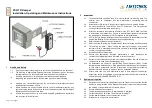
Page 10 of 11 pages
21
Fault finding
21.1
TF actuator
Symptom
Fault
Action
Green LED on the
thermal fuse (TF) is
not illuminated
No power / incorrect supply
Check supply
TF tripped. Remove TF from duct,
separate two halves, continuity
check the two contacts within the
probe section (or test with new
probe)
If open circuit, replace
probe
Actuator faulty
Replace actuator
Blades do not travel
fully open / closed
Synchronization of actuator and
damper incorrect
Remove actuator and
refit. (Refer to sections
15 and 16)
Damper seized
Refer to section 20.11
21.2
NTF actuator
Symptom
Fault
Action
Actuator does not
motor when powered
No power / incorrect supply
Check supply
Actuator faulty
Replace actuator
Blades do not travel
fully open / closed
Synchronization of actuator and
damper incorrect
Remove actuator and refit
(Refer to sections 15 and
16)
Damper seized
Refer to section 20.11
22 Actuator orientation/drive direction change
22.1
Refer to sections 15, 16 and 19. Position the actuator to the required position as
necessary.
23 Commissioning
23.1
The damper cannot be commissioned unless it is fully installed and connected to
mains power in compliance with regulations.
23.2
Dampers controlled by programmable panels need to be commissioned by a
commissioning engineer.
23.3
Electro-mechanically operated dampers can be tested/commissioned by a locally
appointed, competent person.
23.4
The installation needs to be inspected thoroughly, before the damper actuation is
tested.
23.5
Actuation testing should be completed as follows:
23.5.1
Isolate the power.
23.5.2
Remove access door(s).
23.5.3
Test manually, using the crank handle provided, to set the
damper to the ‘normal state’ (powered state). A quarter turn in
the opposite direction locks it. Visually confirm that the damper
is in its ‘normal state’.
23.5.4
Release the motor if it is locked by turning the crank handle a
quarter turn in the winding direction and allow the damper to travel
to ‘fail-safe’ position.
23.5.5
Visually confirm that the damper is in the correct position.
23.5.6
Switch on power to actuator. LED on TF (where present) will
illuminate. The actuator will start to travel to the DRIVE-END
(normal state) position, reaching it within 60 seconds, visually
check that the damper blade-position and signal corresponds.
23.5.7
IMPORTANT: Press and hold test switch lever on TF (where
present) to allow actuator to travel to its SPRING END position.
For NTF actuators the power must be removed from the actuator
to travel to its SPRING END. Visually check that the damper
blade position and signal corresponds. (This is to ensure that the
actuator functions electrically and overrides the manual reset
facility -should it have been used-, as it is feasible to leave the
damper inadvertently reset without the TF being functional if this
test is not carried out!)
23.6
Ensure the damper is left in its ‘normal state’ (powered) before re-fitting access
door/s.











